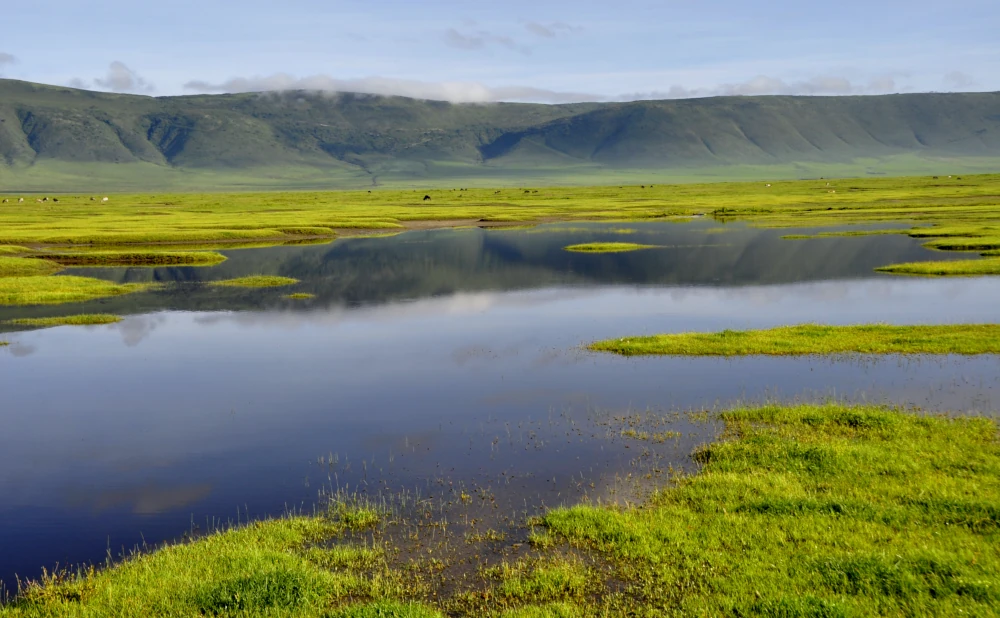
The Ngorongoro Crater, located in the Ngorongoro Conservation Area in northern Tanzania, is one of the most unique and spectacular natural wonders in the world. Here are some key facts about this incredible destination:
1. A UNESCO World Heritage Site
- Designated as a UNESCO World Heritage Site in 1979, the Ngorongoro Crater is one of the most important ecological regions in Africa. Its status as a conservation area helps preserve both the wildlife and the indigenous Maasai communities who live there.
2. World's Largest Inactive Volcanic Caldera
- The Ngorongoro Crater is the world’s largest inactive volcanic caldera. It was formed millions of years ago after a massive volcanic eruption caused the collapse of the cone, leaving behind a deep crater surrounded by steep walls.
- Dimensions: The crater has a diameter of about 19 kilometers (12 miles) and a depth of 610 meters (2,000 feet). It covers an area of around 260 square kilometers (100 square miles).
3. Rich Biodiversity
- Despite being a relatively small area, the crater supports an incredible variety of wildlife, earning it the nickname "Africa's Eden". The lush floor of the crater is home to nearly all of the Big Five (lion, leopard, elephant, buffalo, and rhino), as well as an abundance of other species including cheetahs, hippos, zebras, wildebeests, gazelles, and over 500 species of birds.
- The high concentration of wildlife in such a confined area makes it one of the most ideal places for game viewing in Africa.
4. Home to the Endangered Black Rhino
- The Ngorongoro Crater is one of the few places in Tanzania where you can find the endangered black rhinoceros. Conservation efforts within the crater have helped protect this critically endangered species, and the crater is considered a key sanctuary for black rhinos.
5. Volcanic Soil and Fertile Vegetation
- The soil in the crater is rich and fertile due to volcanic ash, which supports a wide range of plant life. The vegetation varies from grasslands and swamps to dense forests, creating different habitats for the diverse species of flora and fauna.
- The Lemala Hill Forest and Ngoitoktok Springs are examples of lush environments within the crater that provide important resources for wildlife.
6. Ngorongoro Crater’s Natural Features
- Lake Magadi: A large alkaline lake located in the southwestern corner of the crater floor; Lake Magadi is a vital source of water for many of the animals in the crater. It is also a hotspot for flamingos, especially during the wet season.
- Ngoitoktok Springs: This freshwater spring is a key water source for wildlife in the crater, particularly during the dry season.
- Oldupai Gorge: Known as the “Cradle of Mankind,” this ancient archaeological site is located on the crater’s edge and has yielded some of the most important fossils in the study of human evolution.
7. Maasai Community Living Within the Crater
- The Ngorongoro Conservation Area is home to around 40,000 Maasai people, who continue to practice traditional pastoralism. The Maasai live harmoniously with the wildlife in the region, grazing their cattle alongside wild animals such as zebras and wildebeests.
- The coexistence of people and wildlife in such close proximity is a testament to the area’s successful conservation model.
8. Geological and Ecological Significance
- The crater’s ecosystem has been described as an "ecological island" due to its isolation and the unique environmental conditions that support its high concentration of wildlife. The Ngorongoro Crater is a vital area for conservation, as its ecosystem provides essential resources for the surrounding wildlife populations.
9. Accessibility
- The Ngorongoro Crater is easily accessible from Arusha, which is a major gateway to northern Tanzania’s safari circuit. The journey from Arusha to the crater takes about 4 hours by car. Visitors typically stay in lodges or camps located on the crater rim or near the entrance, providing excellent views and easy access to the crater floor for game drives.
10. Climate
- The climate in the Ngorongoro Crater is relatively mild. The altitude of around 2,000 meters (6,600 feet) helps to moderate temperatures, providing a cooler environment compared to the surrounding lowlands.
- The crater experiences a wet season from November to May and a dry season from June to October, which is also the best time for wildlife viewing.
11. Popular Activities
- Game Drives: The main activity within the crater is game driving, where visitors can see a variety of animals in a relatively small area, making it ideal for wildlife photography and viewing.
- Cultural Visits: Visitors can also experience Maasai culture by visiting traditional Maasai villages and learning about their customs and lifestyle.
- Birdwatching: The crater is a paradise for bird watchers, offering the chance to see a wide variety of species, including the flamingos at Lake Magadi and raptors soaring high above the crater.
- Hiking: Some visitors choose to hike along the crater rim for panoramic views, or to trek to nearby Oldupai Gorge for a deeper understanding of human evolution.
12. Conservation Efforts
- The Ngorongoro Conservation Area Authority (NCAA) manages the region to ensure the protection of both wildlife and the Maasai community. Through conservation programs, including efforts to protect endangered species like the black rhino, and responsible tourism, the crater remains one of Africa’s most significant natural and cultural treasures.
